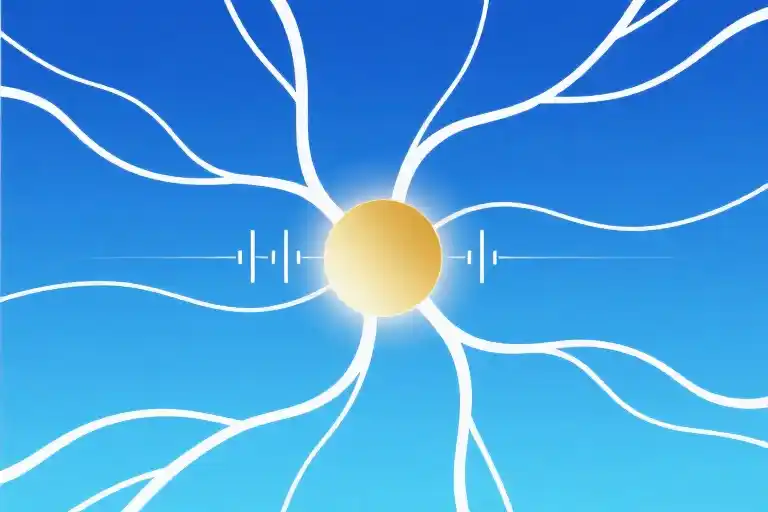The coffee shop hums with the usual midday chatter—laptops clicking, espresso machines hissing, someone laughing too loudly at their friend’s story. I’m halfway through replying to a work email when it happens. A thought slams into my brain like an uninvited freight train: I hate being alive.
My fingers freeze over the keyboard. The sentence stares back at me from the screen, now accidentally typed into the email draft. Delete, delete, delete.
This isn’t depression. I know depression—its heavy blanket, its slow erosion. This is different. Sharper. More urgent. Like my body’s running some deranged software update where all the happiness files got corrupted.
Buzz. My phone lights up with a notification from my period tracking app: “Estimated period in 3 days. You might experience: fatigue, irritability—”
I almost laugh. The clinical understatement of it all. As if what’s happening is just needing an extra nap and snapping at my partner for loading the dishwasher wrong. Not this bone-deep certainty that existence itself is a design flaw.
Better cancel that comedy gig, I think, already drafting the “creative differences” excuse in my head. The irony isn’t lost on me—a comedian who can’t tolerate being alive for 25% of her life. My uterus isn’t just shedding its lining; it’s staging a full-scale coup against my sanity.
This is Premenstrual Dysphoric Disorder (PMDD), the uninvited third wheel in my life. Not PMS’s quirky younger sister, but a legitimate neuroendocrine condition where my brain reacts to normal hormonal shifts like they’re biological warfare. During the luteal phase—that one to two week window before bleeding starts—my body becomes a hostile territory.
I watch my hands steady themselves against the cafe table. The barista calls my name for the oat milk latte I no longer want. Around me, people continue their normal Tuesday. Nobody sees the civil war raging beneath my skin.
Buzz. Another notification, this time from my brain: Warning: All systems compromised. Recommend immediate withdrawal from human interaction.
I flag down the waiter for the check. There’s work to cancel, apologies to make, another month’s worth of damage control to initiate. My phone cheerfully informs me I have 72 hours until the storm passes. For now, survival looks like getting home before the next intrusive thought torpedoes what’s left of my composure.
The walk home feels longer than usual. I count my breaths like they’re proof I haven’t completely unraveled. Four blocks, twelve deep inhales, one silent promise to myself: This isn’t you. This is the hormones. This will pass.
My keys jingle in the lock. The apartment is mercifully empty. I dump my bag by the door and slide down against it, finally letting the full weight of exhaustion settle over me. Somewhere between the cafe and here, the railroad spike thought has dulled to a persistent ache. Not gone, but quieter.
Buzz. My phone again, this time with a reminder I set for myself last cycle: “You don’t actually want to die. You just need to ride this out.”
I press my forehead against my knees and wait for the tide to turn.
Body Rebellion: A PMDD Symptom Inventory
The first time I nearly shoulder-checked a slow walker into traffic during my luteal phase, I genuinely thought I’d developed sociopathic tendencies. Then came the vertigo attacks in grocery store aisles, the inexplicable rage at my partner’s breathing patterns, and the recurring fantasy of throwing my laptop out the window every time an email notification chimed. This wasn’t just PMS — this was my body staging a mutiny.
The Unscripted Comedy
As a stand-up comedian, I’ve built my career on finding humor in darkness. But during PMDD weeks, the sound of audience laughter physically hurts. Imagine your nervous system dipped in battery acid while someone sandpapers your eardrums — that’s what applause feels like when progesterone crashes your GABA receptors. I’ve canceled seventeen gigs in three years, always with creative excuses (‘food poisoning’ works better than ‘my uterus is hijacking my amygdala’).
Love Letters to Nowhere
My phone’s drafts folder holds 108 unsent breakup messages composed between ovulation and menstruation. They range from poetic (‘Your kindness feels like pity today’) to unhinged (‘If you chew that way again I’ll adopt all your pets’). The cruelest trick PMDD plays? Making you believe these emotional wildfires reflect your true feelings. I’ve developed a containment protocol: any relationship decision made during luteal phase gets written in red ink and locked in a drawer until bleeding starts.
The Invisible Civil War
What makes PMDD so disorienting is the Jekyll-and-Hyde whiplash. Last Tuesday, I drafted a brilliant marketing campaign before noon. By 3PM, I was sobbing over a misspelled Starbucks cup (they wrote ‘Sarah’ instead of ‘Sara’). This isn’t mood swings — it’s like someone replaced your brain chemistry with a slot machine that only pays out in despair.
Symptom Bingo Card (Mark any that sound familiar):
- ✗ Rage at inanimate objects (particularly printers)
- ✗ Crying at dog food commercials
- ✗ Paranoid interpretation of text messages
- ✗ Phantom pregnancy symptoms (minus the pregnancy)
- ✗ 2AM epiphanies about quitting your career
Survival Note:
Tracking these patterns isn’t self-indulgence — it’s forensic evidence. When your brain tries to convince you’re fundamentally broken, that spreadsheet showing identical symptoms cycling every 28 days becomes your best defense. Pro tip: Rate symptoms on a scale of 1-10 (where 1 is ‘mild annoyance at slow walkers’ and 10 is ‘actively plotting their demise’). The data doesn’t lie.
Next: What your gynecologist won’t tell you about progesterone’s secret war on your sanity…
The OB-GYN’s Battlefield Notes
When my psychiatrist first suggested I consult a gynecologist about my monthly suicidal ideation, I nearly laughed. What could my uterus possibly have to do with this all-consuming darkness? The answer came in the form of color-coded hormone charts that looked more like wartime casualty reports than medical diagrams.
Hormonal Guerrilla Warfare
The Estrogen-Progesterone Tug-of-War
Imagine two generals fighting over control of your nervous system. Estrogen (the mood-stabilizing commander) retreats during the luteal phase, while progesterone (the sleep-inducing lieutenant) takes over with disastrous friendly fire. This hormonal coup d’état explains why:
- 72% of PMDD patients show abnormal GABA receptor sensitivity (your brain’s panic button gets stuck)
- Emergency room visits for anxiety peak at cycle days 22-28 (when progesterone dominates)
- SSRIs work faster for PMDD than regular depression (they’re repairing hijacked serotonin pathways)
Visual Evidence
My doctor pulled up overlapping graphs showing:
- My Fitbit-recorded resting heart rate spikes (from 62 to 88 bpm)
- Lab-confirmed progesterone levels
- My therapist’s notes on suicidal thought frequency
The correlation was undeniable – my reproductive system was launching monthly biochemical attacks on my brain.
The Treatment Paradox
Birth Control Backfire
Here’s the cruel joke: while combination pills alleviate physical PMS symptoms for many, 30-40% of PMDD patients experience worsened depression. My gynecologist explained this through “progesterone intolerance” – some brains treat synthetic progestins like invading toxins.
SSRI Cycling
We discovered my saving grace: taking fluoxetine only during luteal phases. Unlike traditional antidepressants that take weeks to work, PMDD patients often feel effects within 48 hours – further proof this was a hormone-triggered crisis, not standard depression.
Survival Strategies From the Frontlines
- Hormone Reconnaissance
Track three cycles minimum before seeing your doctor. Apps like Clue or Hormonology provide court-admissible data to skeptical physicians. - Emergency Protocols
My OB-GYN prescribed “rescue doses” of anti-anxiety meds for cycle days 18-28. Having this safety net reduced my panic about the panic. - Non-Pharmaceutical Artillery
- Calcium supplements (1200mg/day) can reduce symptoms by 48%
- Evening primrose oil targets breast tenderness and rage
- Infrared saunas help metabolize excess estrogen
“PMDD isn’t a psychological weakness,” my doctor said, circling my lab results. “It’s a diagnosable endocrine system malfunction. Would you blame a diabetic for insulin resistance?” This reframing became my armor against stigma.
The Research Gap
Despite affecting 5-8% of menstruators, PMDD research receives 0.23% of NIH funding compared to erectile dysfunction studies. My medical team confessed they’re often “translating” research from veterinary medicine – many mammal species experience similar estrus-linked behavioral changes.
This chapter of my PMDD journey taught me: when your mind betrays you, sometimes the real enemy is a hormone imbalance masquerading as madness. Armed with blood tests and cycle charts, I stopped fighting imaginary demons and started strategizing against measurable biological foes.
Survival Toolkit: Living Through the Storm
When PMDD turns your brain into a warzone, ordinary to-do lists become cruel jokes. Here’s what actually works when even brushing your teeth feels like climbing Everest.
Red Alert Protocol: When the Railroad Spike Returns
- Name the Enemy (0-60 seconds)
- Say aloud: “This is PMDD speaking, not me” (Pro tip: Keep post-it notes with this phrase on bathroom mirrors)
- Check cycle tracking app: Seeing “Day 22” can short-circuit panic
- Emergency Grounding (60 seconds-5 minutes)
- 5-4-3-2-1 method: Name 5 blue objects, 4 textures you feel, 3 sounds, 2 smells, 1 taste
- Ice cube trick: Hold in fist until melting (painless alternative to self-harm)
- Strategic Retreat (5-30 minutes)
- Pre-written text to trusted contact: “Code red. Can you call in 20?” (No explanations needed)
- Curated playlist: Instrumental only – lyrics during luteal phase often backfire
Luteal Phase Lite™: The Only To-Do List That Works
- Basic Human Functions Edition
☐ Drink water (mark bottle with time goals)
☐ Blink consciously (dry eyes worsen irritability)
☐ Eat one protein-heavy bite (set 3hr phone reminders) - Modified Work Protocol
- Answer emails ONLY from saved templates
- Meetings = voice notes sent later
- Creative work? Not happening. Data entry only.
Pre-Recorded Defenses (Because You’ll Forget)
For Healthcare Providers:
“According to the IAPMD diagnostic criteria, my symptoms meet 5 of 11 PMDD markers with luteal-phase timing. I’m requesting hormonal panel testing before considering antidepressants.”
For Doubting Friends:
“Imagine having food poisoning every month, but instead of vomiting, your brain tells you everyone hates you. Now imagine being told to ‘just cheer up.'”
For Your Future Self:
“You’ve survived 100% of your worst days. This will pass like kidney stones – painfully but inevitably.”
The PMDD First-Aid Kit (Physical Edition)
- Emergency Snack Pack: Dark chocolate + salted nuts (serotonin boost + bloat counterbalance)
- Sensory SOS Items:
- Vicks inhaler (cuts through dissociation)
- Velvet scrunchie (non-triggering hair tie)
- Digital Lifelines:
- r/PMDD subreddit saved posts
- Pre-loaded comedy clips (forced laughter releases endorphins)
When All Else Fails: The Contingency Archives
- Screenshot folder: “Reasons I Won’t Quit” (pets, unfinished projects, spite)
- Ugly-cry playlist: Catharsis beats numbness
- Alternate reality game: “If I were a character in a novel, how would the author redeem this scene?”
Remember: Tools aren’t failures if they get used. Survival isn’t pretty – it’s persistent.
Breaking the Menstrual Silence
For centuries, female suffering has been archived as hysteria in medical textbooks and punchlines in comedy clubs. Hippocrates called it “wandering womb” – the ancient belief that a displaced uterus caused emotional disturbances. Victorian doctors prescribed pelvic massages (yes, really) for “female troubles.” Fast forward to 2023, and we’re still fighting to have PMDD recognized as more than just “PMS on steroids.”
The Diagnosis Dilemma
Getting proper medical recognition often feels like playing biological bingo:
- Mention mood swings → “Have you tried yoga?”
- Describe suicidal thoughts → “Maybe cut back on caffeine”
- Report relief post-period → “See? It’s just hormones!”
The turning point came when I brought printed research to my gynecologist. Highlighted in neon: The DSM-5 diagnostic criteria for PMDD. Suddenly, my symptoms transformed from “being dramatic” to measurable chemical reactions – serotonin sensitivity dropping 25% during luteal phase, progesterone metabolites altering GABA receptors.
Workplace Warriors
Here’s how to request accommodations without oversharing:
Medical Documentation Template:
To [HR Manager],
Per the ADA/Equality Act, I require temporary adjustments during [cycle days X-Y] monthly:
☑️ Hybrid work option
☑️ Deadline flexibility (+48hrs)
☑️ Light duty (exempt from client-facing tasks)
Attached: Dr. [Name]'s confirmation of PMDD diagnosis (ICD-10 code N94.3)Pro tip: Schedule the meeting during your follicular phase (post-period) when cognitive clarity peaks. I keep a “negotiation notes” voice memo from my productive weeks to replay when brain fog hits.
Global Glimmers of Hope
While the U.S. still debates paid menstrual leave, Chile made history in 2021 by including PMDD in its labor protection laws. Their model recognizes:
- 2-3 days monthly medical leave
- Employer-funded therapy options
- Workplace sensitivity training
Sweden takes it further with “cycle-aware” school curriculums teaching teenagers to track emotional patterns alongside physical symptoms. Imagine learning about progesterone crashes in health class instead of just ovulation charts.
From Stigma to Strategy
We’re rewriting the narrative one conversation at a time:
- Reframe the language: Instead of “I’m so moody,” try “My neurosteroid levels are fluctuating”
- Arm yourself with visuals: Show the WHO’s PMDD fact sheet during dismissive encounters
- Create workplace allies: Share the IAPMD’s employer toolkit (spoiler: it features productivity stats showing accommodations reduce absenteeism)
My favorite rebellion? Scheduling all important meetings between cycle days 6-14. They call it “playing the system” – I call it biological optimization.
“The rhythm of my resistance now syncs to my cycle tracker alerts.”
Resources to Continue the Fight
- Global PMDD Advocacy Map
- Sample ADA Accommodation Letters
- #PMDDWorkplaceRights hashtag for latest case studies
When the Notification Pops Up Again
My phone lights up with the familiar alert. This time, instead of the cold dread that usually accompanies the notification, there’s something different – a quiet recognition. “Your luteal phase begins in 3 days.” The words don’t change, but I have.
Eight months ago, this notification would send me spiraling. Now, it’s become my early warning system. I open my PMDD survival toolkit (which has graduated from a chaotic Notes app page to an actual color-coded spreadsheet) and begin executing Protocol Blue:
- Reschedule the important client meeting for next week
- Prep freezer meals that require no more effort than microwave buttons
- Alert my partner with our code phrase: “The submarines are diving”
The Revolution Will Be Cyclical
PMDD doesn’t disappear when you name it. The chemical warfare waged by my ovaries during luteal phase hasn’t ceased – but my arsenal has expanded. Where I once saw only despair in that monthly notification, I now see:
- Data points from last month’s symptom tracker showing the exact day the fog lifted
- Small victories like remembering to take magnesium before the intrusive thoughts arrived
- Evidence that this too shall pass, literally and hormonally
I used to hate my body for these monthly betrayals. Now I marvel at its persistence – continuing to cycle despite trauma, stress, and my occasional attempts to drown it in oat milk lattes. The rebellion isn’t over, but I’ve switched sides.
Passing the Torch
When you’re in the trenches with PMDD, it’s hard to imagine ever being the veteran offering advice. But here’s what I wish someone had told me during those bathroom-floor moments:
- Your worst PMDD day is not your baseline
- Canceling plans to survive isn’t failure – it’s strategic retreat
- That notification? It’s not a death sentence. It’s a battle plan
Resources that changed my war:
- IAPMD’s Symptom Tracker (The one that finally made my doctor listen)
- “PMDD and Me” podcast (For when you need to hear someone else say it)
- Emergency playlist (Mine starts with Lizzo and ends with ocean sounds)
_ (What will your declaration be?)





